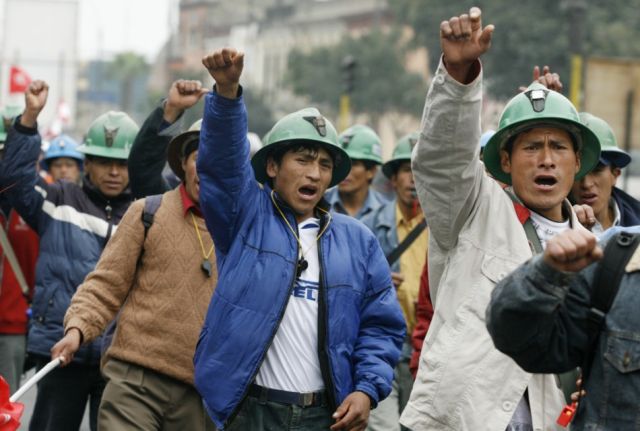
Tintaya is an open-cut copper and gold mine 4000 metres high in the district of Yauri, Espinar province, southern Peru. It is a spectacle of modern industrial devastation that contrasts jarringly with the timeless beauty of the surrounding altiplano landscape.
Finally, after years of aggravated environmental abuse, the mine's owner, Swiss-based Xstrata, will be investigated by Peruvian authorities.
After the discovery of large deposits, a copper mine was established at Tintaya in the mid-1980s. Extractive operations were hugely expanded when BHP bought the site in 1996.
In the absence of enforced environmental standards, BHP's waste disposal methods were cheap, primitive and highly toxic.
When livestock began dying after drinking local water, a protest movement emerged. Activists claimed the mine represented a fundamental assault on their way of life, which has co-existed with the local environment for millennia.
Their cause attracted the sympathetic attention of various international NGOs, but not the “investment-friendly” Peruvian government ― which has only featured an environment ministry since 2003.
For years, the Peruvian state and corporate-owned media have conspired to denigrate and demonise provincianos, such as the people of Espinar, who have called for a mining moratorium.
In this situation, where indigenous protesters are regularly labelled “savages” or “terrorists”, huge mining corporations have been able to operate with virtual impunity.
To stave off further popular action, BHP made a few token concessions to Espinar's residents, but they were largely cosmetic.
In 2006, Xstrata paid BHP $US750 million for the controversial asset. Press releases gloated over the strategic importance of Tintaya in the company's quest to dominate the international copper market.
No importance was attached to the existing social conflict generated by Tintaya, though some glib assurances were offered that Xstrata would work in collaboration with the people of Espinar.
In reality, as Xstrata planners were fully aware, the profitability of the Tintaya mine depends on the continued despoliation of the local environment.
Company sources say nearly 100,000 tonnes of copper and 30,000 ounces of gold were extracted from Tintaya last year. Such “impressive” results were made possible only by utilising cut-throat extraction methods that would be difficult to pursue in a host country with more sovereign power.
Solid waste is routinely dumped in tributaries that flow into the Salado and Canipia rivers. Tailings dams produce acid-tainted dust that often infiltrates residential areas.
The company admits to all this with a complacent attitude, claiming that within five years it will have done what it can to reduce contamination. Whatever it is doing, it is clearly not enough.
Scientific findings support what locals have been saying anecdotally, that the rivers are now so polluted by mining that it is dangerous for livestock or people to drink the previously-pristine waters.
An environmental monitoring study conducted by Germany's Christian Albrecht University recently concluded that the Salado and Canipia contain unacceptably elevated levels of aluminium, arsenic and iron.
Another study by Cusco-based environmental authorities discovered that 26 residents of Espinar had dangerous levels of mercury, cadmium and lead after drinking from the affected rivers.
Gone are the days when graziers from all over southern Peru would make their way to Yauri to buy cattle in the market.
This decline, with its catastrophic repercussions for Espinar's agricultural economy, is a direct result of Tintaya's expansion.
Similar trends are evident all over Peru, which has experienced a dramatic influx of foreign mining capital in the past decade.
Last year, popular resentment over the direction of the mining boom helped elect a president with a left-nationalist background ― Ollanta Humala.
Generally speaking, Peruvian voters were not “anti-mining” as such but they wanted a more equitable distribution of mineral profits with improved environmental and human rights standards.
Although the new, “respectable” Humala is toeing a more corporate friendly line, his presidency has at least afforded some protesters the chance to have their voice heard.
In November, a broad coalition representing Espinar's residents initiated proceedings against Xstrata with the Cusco office of the Peruvian environmental ministry.
Official documents detailing the extent of environmental contamination have been filed, and copies sent to Xstrata, relevant Peruvian authorities and the Swiss embassy.
This is only the beginning of what is certain to be a lengthy and frustrating legal process. But it is a cautiously hopeful sign that the concerns of Peru's mining-affected communities will be taken more seriously by the national government.
Under previous, more rampantly neoliberal administrations, it is highly unlikely that such an investigation would ever have occurred.
The mayor of Espinar, Oscar Mollohuanca, has expressed the hope that in response to the proceedings, Xstrata will adopt a different attitude. He hopes they will lead to a “new era of dialogue, conversations and negotiations that will result in the resolution of problems in Espinar”.
Xstrata has responded by promising to cooperate fully with the investigation, but it remains to be seen if this is anything more than a stonewalling tactic. Xstrata representatives have as yet failed to divulge the results of their own environmental studies to investigating authorities.
Clearly, the people of Espinar are doing everything possible to vent their concerns in a constitutional manner. They are to be admired for chipping away at the monopolistic power of the corporate overseer in their province, but can they re-set the power relationship?
The investigation of Xstrata-Tintaya represents a serious test of the Humala administration´s stated commitment to social and environmental justice. Having cracked down on anti-mining street protests in Cajamarca, the government needs to show a meaningful alternative avenues of “legitimate” protest do exist in today's Peru.
If, however, the investigation turns into an exercise in pro-corporate obfuscation, the people of Espinar may be forced to take more direct action against Tintaya.
